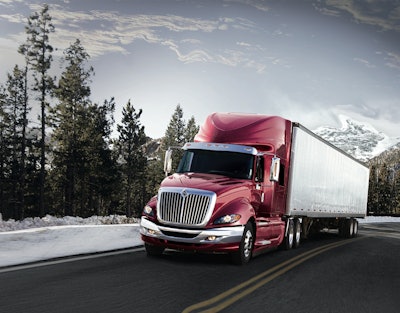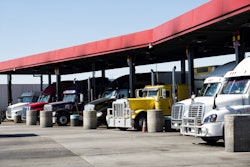
 Troy Clarke, left, and Andreas Renschler, middle, talked the fledgling partnership between Navistar and Volkswagen at a meeting with trucking industry press at the bi-annual IAA show in Hanover, Germany, Sept. 21.
Troy Clarke, left, and Andreas Renschler, middle, talked the fledgling partnership between Navistar and Volkswagen at a meeting with trucking industry press at the bi-annual IAA show in Hanover, Germany, Sept. 21.Even though there only a handful of players, the OEM truck business in North America is a complex market. All major players, save one, have relationships or ownership in countries that provide a global presence – Volvo and Mack, Daimler with Freightliner and Western Star and Paccar and DAF.
Until two weeks ago, Navistar was the only player in the North American market without true international ties, and Volkswagen was a major European player without a stake in North America. That all changed with the announcement from Navistar and Volkswagen that the German truck and bus maker had secured a 16.6 percent stake in Navistar.
Top brass from the two companies sat down with the North American press for a roundtable discussion of the new partnership and what it means for both companies as well as Navistar’s existing North American fleet customers and dealers.
“We are looking forward to a successful alliance,” said Andreas Renschler, CEO of Volkswagen Truck & Bus. “Navistar needs what we can offer drivetrain-wise – including engine, transmission and axle. [Volkswagen] is at the moment developing new product lines, and we can put all the requirements from Navistar into that development.”
Dialogue between Navistar and Volkswagen – which also operates the MAN and Scania business units in Europe and abroad – began a year ago on opportunities to synergize and strengthen each company, culminating in Volkswagen’s recent investment.
“You see a lot of change [in the trucking industry] and we are excited to have found a partner that looks at future the way we do and with whom we have a high degree of alignment,” said Troy Clarke, CEO of Navistar. “We have a common vision on how the industry will develop and how to address those issues. That we can do it better together makes it a perfect fit.”
With its investment, Volkswagen now has an equal stake with Navistar’s two largest existing shareholders, according to Navistar CFO Walter Borst. “We’ll be able to explore advanced technologies, and for Navistar to do that on our own would be cost-prohibitive,” he added.
The timing of Volkswagen’s investment couldn’t be better for Navistar, a company that is climbing back from the ill-fated decision to pursue exhaust gas recirculation technology to meet the U.S. Environmental Protection Agency’s 2010 emissions standards when the rest of the industry ultimately went with selective catalytic reduction solution.
“Unfortunately we turned left and they went right,” said Clarke. “We have done a lot to repair ourselves and make us a good partner but also are a good standalone company. Our business is operating as well as it has in a long time. This [partnership] doesn’t solve all the problems our company has, but it creates opportunities we didn’t have a few weeks ago.”
Clarke said customer reaction from both large fleets and Navistar’s dealer network has been extremely positive in the two weeks since the announcement, but added that customers shouldn’t look for a new engine solution in the next few years.
“We are going to look at where the industry will be 10 to 15 years from now and work back from that point,” said Clarke, but added the two companies will look for immediate opportunities to create working processes on new projects.
“We are looking forward to understanding where those opportunities exist,” added Clarke, pointing to Volkswagen’s new RIO telematics and connectivity architecture as an example, a solution similar to Navistar’s OnCommand Connection solution in North America.
Renschler pegged 2021 as a realistic target date for Volkswagen to deliver an engine solution developed specifically for the needs of Navistar’s customers in the North American market, but stressed the companies would share technologies to strengthen both brands as opposed to Volkswagen simply supplying a powertrain solution to Navistar customers.
“As a group, we have potential because we can use components from each other and go into [emerging] markets,” said Renschler. “No one regional player alone can do that. We have a mission to bring transport to the next level and will move from being a hardware manufacturer to focus on transport efficiency. New drivetrain technology is one thing, but to enable our customers more profitable and more efficient, that is our goal.
Renschler is no stranger to the North American truck market, having served as head of Daimler Trucks until two years ago, but noted a number of changes in the industry during that time, including the rapid adoption of automated manual transmissions, air disc brakes and now the push toward autonomous technology.












